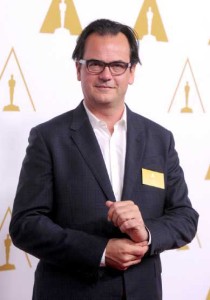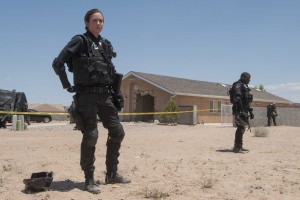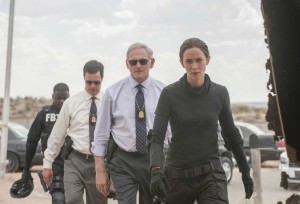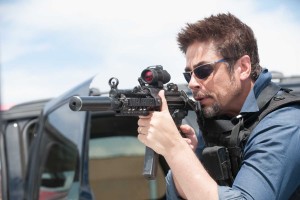![]()

Penned by Taylor Sheridan, the fictional story is told with blind accuracy, painting a realistic narrative of today’s drug war on the U.S.-Mexico border. At the center of it all is Kate Macer (Emily Blunt), an FBI agent, who’s asked to join a lawless task force trying to bring balance back to the region. What makes the film compelling is its unconditional sense of pace that’s accompanied by a plethora of arresting imagery from cinematographer Rodger Deakins. Poetically piecing it all together was editor Joe Walker, who said, “The story plays on the idea of how far are you prepared to go for an understandable and just cause into unjustified darkness.”
While it was Walker’s first time working with the director, the editor admits Villeneuve was a fan of the work he did with Steve McQueen. “Those films were characterized by their bold approach to pace. With Sicario, it’s not really about being slow or fast, but about prolonging tension and sometimes that’s achieved as a matter of what I call landscape. It’s that sort of thing of using time in a scene in order to create the intensity.”

Sicario is played almost entirely through Kate’s perspective and one of the task force members she’s trying to figure out is Alejandro (Benicio Del Toro). He’s a quiet, deceptive character that as an audience member you’re trying to place your finger on up until the final acts. But the intrigue may have never taken shape if it wasn’t for a scene Walker omitted. “There are probably a few people that won’t forgive me for dropping a very substantial scene we had at the beginning of the movie. It was a heart-breaking sequence where Alejandro is standing in water drowning a cop, interrogating him. He actually ends up holding the man’s head underwater too long and he dies. But Alejandro drags him out of the water, gives him CPR to revive him, only to interrogate him more. It was just a wicked scene,” Walker recalled. “The problem to me was that the equilibrium of the story was better if we kept it to Kate’s point of view and to discover who Alejandro is when Kate does. The counterpoint to that was Silvio [Maximiliano Hernández], the Mexican cop we see with his son and wife. You don’t know how he’s going to play into the story, but you know it’s going to end badly. You’re slowly finding out about Silvio, and to me, that was much better counterbalance against Kate to have another tangential story that wasn’t connected to the plot.”
 One of those telling moments to Alejandro’s character is an interrogation scene where he walks casually down a hallway with a five gallon water jug in-hand. “I loved that shot of Alejandro coming towards us. He has this swagger to him then the audio trick of hearing Josh Brolin’s character [Matt] whistling ‘Hail to the Chief’ in the other room. There’s all this dread about it. With Roger’s stuff, you’re cutting the best cinematography in the world and it allows you to be super muscular and rhythmic. In a way, it’s almost a matter of pride to subvert some of that because it’s so strong. I would always try to find a way to reinvent some scenes just to get in there,” said Walker. “But that shot, the angle of where it’s from, the meticulous planning and fidelity of the material – you’re totally clear where it’s going and it allows you to go to the edge of the cliff and then pull it back.”
One of those telling moments to Alejandro’s character is an interrogation scene where he walks casually down a hallway with a five gallon water jug in-hand. “I loved that shot of Alejandro coming towards us. He has this swagger to him then the audio trick of hearing Josh Brolin’s character [Matt] whistling ‘Hail to the Chief’ in the other room. There’s all this dread about it. With Roger’s stuff, you’re cutting the best cinematography in the world and it allows you to be super muscular and rhythmic. In a way, it’s almost a matter of pride to subvert some of that because it’s so strong. I would always try to find a way to reinvent some scenes just to get in there,” said Walker. “But that shot, the angle of where it’s from, the meticulous planning and fidelity of the material – you’re totally clear where it’s going and it allows you to go to the edge of the cliff and then pull it back.”
Production filmed in a handful of cities – Albuquerque, New Mexico, El Paso, Texas and Veracruz, Mexico – which provided Walker with an assortment of beautiful but barren landscape shots. “They selected a fairly ominous setting for the film and Blunt’s character, Kate. Her apartment isn’t well equipped, with only a few items in her cupboard. There’s even a very revealing shot where we only see a few coat hangers in her closet. It was made to feel very temporary. Her back story is that she’s recently divorced – nothing too in your face,” Walker explained. By inserting the landscape imagery into the timeline, it not only provided a break from the more intense moments, but they also subliminally played to Kate’s emptiness and the uncertainty that she felt. “Denis and Roger are very smart, cinematic thinkers,” said Walker. “I came from a music and television background so I tend to really celebrate those things that have an impact on a big screen and place them in the edit.”

Throughout the film, the editor compiled sequences with intensifying details and unapologetic emotion that we’ve come to expect from a Villeneuve picture. You could even say Walker got in a few of his own, extending shots a little longer than expected like in 12 Years a Slave. One in particular was a scene between Kate and Matt after crossing back from the Mexico border. As the two leave the vehicle, Kate finally breaks down and starts yelling at Matt. The entire sequence was done without any close-ups but one wide shot. “I would like to take credit for that decision, but that’s all they filmed,” Walker laughed. “They had the time to shoot additional material, but Denis saw the special quality of the shot – with the American flag in the background the dust rolling. But honestly, the setup to that scene was so compressed in time. All of Kate’s anger and dismay – everything that happened really disturbed her, it could have started a war. The scene between them played very well in the wide shot. Let’s put it this way, I would love to say that I influenced that because I would have recommended not using any close-ups, so I am going to take credit for it.”
For Walker, what attracted him to the project besides working with Villeneuve was the nature of the story. “To me, it was a very sarcastic film that I am very at home with being British. Look at Josh Brolin’s character – he goes from the guy wearing flip flops to almost looking like the devil when he’s pushing Kate’s face into the dirt. There were very deliberate arcs to these characters and I really liked that about the film.”





